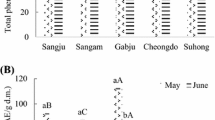Abstract
Fresh, naturally dried, and artificially dried persimmon (Diospyros kaki cv. Fuyu) flower buds (PFBs) were extracted with deionized water (1 g/100 mL) at five temperatures (60, 70, 80, 90, and 100°C) for 4 soaking times (30, 60, 120, and 180 s). DPPH and ABTS radical scavenging activities were enhanced with increasing extraction time and temperature. Extraction time and temperature in fresh PFB extract led to little differences in total phenolic contents (TPCs). However, naturally and artificially dried PFB extracts significantly changed TPCs. The extracts of artificially dried PEB for 180 s at 100°C contained the highest TPC: 43.07 μg gallic acid equivalents/g. These results suggest that the drying method and soaking condition are important for the application of PFBs to a functional food material.
Similar content being viewed by others
References
Steinmetz KA, Potter JD. Vegetables, fruit, and cancer prevention: A review. J. Am. Diet. Assoc. 53: 536–543 (1996)
New Food Composition Table Editing Committee. New Food Composition Table. Hitotsubashi Press Co., Tokyo, Japan. pp. 90–91 (2009)
Chen XN, Fan JF, Yue X, Wu XR, Li LT. Radical scavenging activity and phenolic compounds in persimmon (Diospyros kaki L. cv. Mopan). J. Food Sci. 73: C24–C28 (2008)
Akter MS, Eun JB. Characterization of insoluble fibers prepared from the peel of ripe soft persimmon (Diospyros kaki L. cv. Daebong). Food Sci. Biotechnol. 18: 1545–1547 (2009)
Veberic R, Jurhar J, Mikulic-Petkovsek M, Stampar F, Schmitzer V. Comparative study of primary and secondary metabolites in 11 cultivars of persimmon fruit (Diospyros kaki L.). Food Chem. 119: 477–483 (2010)
Gorinstein S, Kulasek GW, Bartnikowsk E, Leontowicz M, Zemser M, Morawiec M, Trakhtenberg S. The influence of persimmon peel and persimmon pulp on the lipid metabolism and antioxidant activity of rats fed cholesterol. J. Nutr. Biochem. 9: 223–227 (1998)
Gorinstein S, Bartnikowsk E, Kulasek G, Zemser M, Trakhtenberg S. Dietary persimmon improves lipid metabolism in rats fed diets containing cholesterol. J. Nutr. 128: 2023–2027 (2000)
Lee MR, Moon SH, Choi AR, Lee SC, Ahn GH, Park HR. Neuroprotective effects of extracts from Diospyros kaki L. peel. Korean J. Food Cookery Sci. 27: 67–73 (2011)
Funayama S, Hikino H. Hypotensive principles of Diospyros kaki leaves. Chem. Pharm. Bull. 27: 2865–2868 (1979)
Maeda M, Kohsaka A, Kishioka S, Iwahashi H, Ikeda H, Takeshita T, Miyashita K, Arita M, Tomita K, Waki H. Physiological study of prevention of hangovers by persimmons. Auton. Neurosci.-Basic 158: 136–136 (2010)
Gorinstein S, Zemser M, Weitz M, Halevy S, Deutsch J, Tilus K, Feintuch D, Guerra N, Fishman M, Bartnikowska E. Fluorometric analysis of phenolics in persimmon. Biosci. Biotech. Bioch. 58: 1087–1092 (1994).
Kameda K, Takaku T, Okuda H, Kimura Y, Okuda T, Hatano T, Agata I, Arichi S. Inhibitory effects of various flavonoids isolated from leaves of persimmon on angiotensin-converting enzyme activity. J. Nat. Prod. 50: 680–683 (1987)
Jo KJ, Lee JM, Lee SC, Park HR. Anticancer activity of persimmon (Diospyros kaki L.) calyx extracts on human cancer cells. J. Med. Plants Res. 5: 2546–2550 (2011)
You DH, Lee SC. Antioxidative properties of different solvent extracts from persimmon (Diospyros kaki cv. Fuyu) flower buds. J. Food Sci. Nutr. 16: 328–332 (2011)
AOAC. Official methods of analysis of AOAC Int. 16th ed. Method No. 930.04. Association of Official Analytical Chemists, Washington, DC, USA (1995)
Lee SC, Kim JH, Jeong SM, Kim DR, Ha JU, Nam KC, Ahn DU. Effect of far-infrared radiation on the antioxidant activity of rice hulls. J. Agr. Food Chem. 51: 4400–4403 (2003)
Re R, Pellegrini N, Proteggente A, Pannala A, Yang M, Rice-Evan C. Antioxidant activity applying improved ABTS radical cation decolorization assay. Free Radical Bio. Med. 26: 1231–1237 (1999)
Gutfinger T. Polyphenols in olive oil. J. Am. Oil Chem. Soc. 58: 966–968 (1981)
Sikic BI, Mimnaugh EG, Litterst CL, Gram TE. The effects of ascorbic acid deficiency and repletion on pulmonary, renal, and hepatic drug metabolism in the guinea pig. Arch. Biochem. Biophys. 179: 663–671 (1977)
Bae MS, Lee SC. Effect of deep sea water on the antioxidant activity and catechin content of green tea. J. Med. Plants Res. 4: 1662–1667 (2010)
Jang IC, Jo EK, Bae MS, Lee HJ, Jeon GI, Park E, Yuk HG, Ahn GH, Lee SC. Antioxidant and antigenotoxic activities of different parts of persimmon (Diospyros kaki cv. Fuyu) fruit. J. Med. Plants Res. 4: 155–160 (2010)
Sakanaka S, Tachibana Y, Okada Y. Preparation and antioxidant properties of extracts of Japanese persimmon leaf tea (kakinohacha). Food Chem. 89: 569–575 (2005)
Nicoletta P, Roberta R, Min Y, Catherine RE. Screening of dietary carotenoids and carotenoid-rich fruit extracts for antioxidant activities applying 2,2′-azinobis (3-ethylbenzothiazoline-6-sulfonic acid) radical cation decolorization assay. Method Enzymol. 299: 379–389 (1999)
Rice-Evans CA, Miller NJ, Paganga G. Structure-antioxidant activity relationships of flavonoids and phenolic acids. Free Radical Bio. Med. 20: 933–956 (1996)
Gorinstein S, Zemser M, Haruenkit R, Chuthakorn R, Grauer F, Martin-Belloso O, Trakhtenberg S. Comparative content of total polyphenols and dietary fiber in tropical fruits and persimmon. J. Nutr. Biochem. 10: 367–371 (1999)
Davey MW, Van Montagu M, Inzé D, Sanmartin M, Kanelli, A, Smirnoff N, Benzie IJJ, Strain JJ, Favell D, Fletche J. Plant l-ascorbic acid: Chemistry, function, metabolism, bioavailability, and effects of processing. J. Sci. Food Agr. 80: 825–860 (2000)
Mishkin M, Saguy I, Karel M. A dynamic test for kinetic models of chemical changes during processing: Ascorbic acid degradation in dehydrated potatoes. J. Food Sci. 49: 1276–1274 (1984)
Author information
Authors and Affiliations
Corresponding author
Rights and permissions
About this article
Cite this article
Youn, UY., Choi, SY., Kim, SK. et al. Antioxidant activity of water extracts of persimmon flower buds. Food Sci Biotechnol 24, 281–286 (2015). https://doi.org/10.1007/s10068-015-0037-8
Received:
Revised:
Accepted:
Published:
Issue Date:
DOI: https://doi.org/10.1007/s10068-015-0037-8




